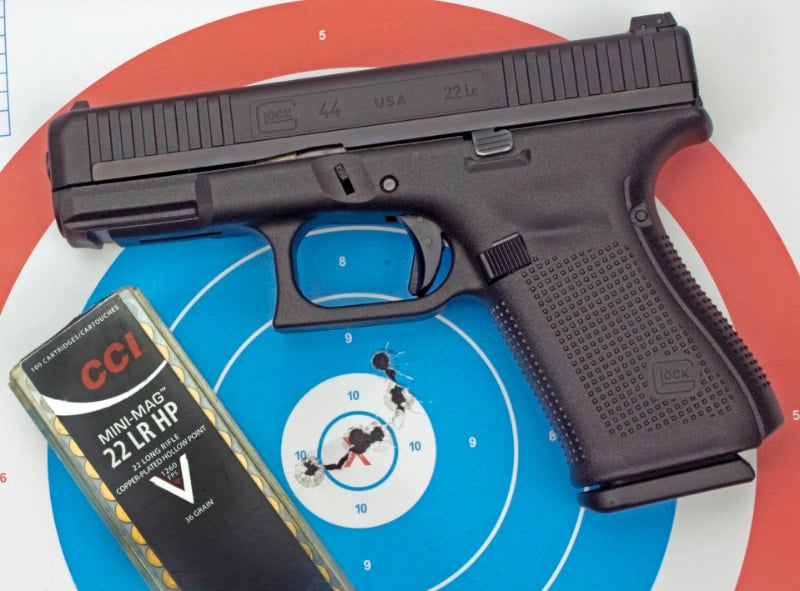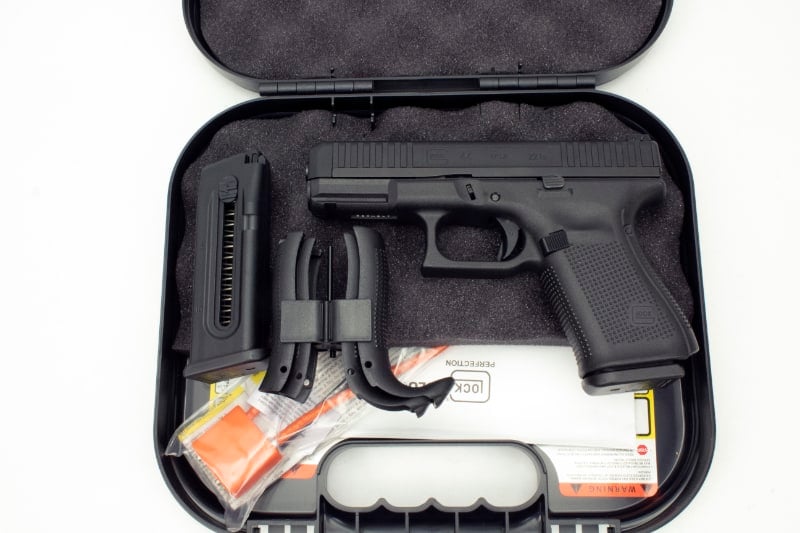GLOCK G44 .22 LR
GLOCK’s .22 caliber G44 is made right here in the USA. It’s not the first GLOCK made in their Georgia facility, but it is still interesting to see. All of the GLOCKs I had seen before had been made in Austria. A little investigation revealed GLOCKs made in America were all sold overseas while GLOCKs sold in America had been made in Austria due to import/export laws. It took the severe gun shortage during the Obama years to get American-made GLOCKs on American shelves.
Familiar Look and Feel
From the outset, the G44 looks like just another GLOCK. It came in the same style case and looked like a G19 Gen5, but with an extra magazine and four extra backstraps to adjust the grip size. The true difference lies in the weight. The GLOCK G44 with an empty magazine weighs less than 15 oz. The 9mm G19 weighs almost 24 oz. Its similarities to its 9mm cousin emphasize the G44’s value as a rimfire training tool. It’s also just plain fun. I passed it around on the range to see others’ reactions. Several GLOCK owners were surprised and excited to discover they could shoot a gun similar to their carry gun but with almost no recoil and less expensive ammo.
Making a semi-automatic .22 cycle reliably can be a challenge because there’s just not enough pressure in those cartridges to cycle a heavy slide. That’s why most .22 pistols have been blowback models with fixed barrels and some sort of charging handle. They just don’t operate like our heavier caliber guns. GLOCK solved the problem by making a lightweight slide out of a hybrid steel polymer that retains the strength necessary for long-lasting durability. Although the frame is very similar to the G19 and other GLOCK models, the rails are smaller and lighter, resulting in less friction. The resulting engineering makes for a gun that functions reliably when using clean, modern ammunition. Does it work perfectly with everything? No, but it will work with enough ammo brands and types for you to enjoy your outings without the aggravation of failures to feed or eject.
It's Definitely a GLOCK
GLOCKs are popular the way Toyotas are popular because you can always count on them to work as designed and to accomplish the mission for the masses. I’ve never been one to follow the crowd, but whenever I shoot a GLOCK, I can’t find a reason not to like it. They handle well, they shoot well, and they do it in such a variety of conditions — even abuses —that you can’t really say anything bad about them.
The frame is polymer, 7.28″ long, 5.04″ high and 1.26″ thick. G19 dimensions exactly. The barrel length is 4.02″. The grip, including the front strap and back strap, is aggressively stippled. The four additional backstraps allow you to increase the circumference of the grip (two also increase the beavertail, two do not). The small frame grip on the gun fits me fine, so I didn’t alter it. There’s a rail in the correct place for accessories. The front of the trigger guard is flat with a slight recurve that provides a perfect place for the support hand forefinger. The back of the trigger guard has a nicely-sized undercut to allow a high grip with the shooting hand. Being a first model, the G44 is not a Gen anything, but has the Gen 5 enhancements of the other models. These include cocking serrations on the front of the frame, no finger grooves on the grip and rounded front edges of the frame and slide to aid in holstering. The sights have the familiar GLOCK white dot in front with a squared off U for the rear sight which is adjustable for windage and elevation. The slide lock is a small metal tab that’s easy to operate while the mag release is rectangular shaped with lines that help increase friction and can be reversed for left-handed shooters. Magazines drop freely when the button is fully depressed. The trigger is GLOCK’s bladed, safe-action trigger with the same 5.5-lb. pull found on virtually all GLOCKs. The magazine’s external dimensions are similar to those of the G19 magazine. Large plastic tabs, one on each side of the magazine, make it easy to pull down the follower so you can load the 10-round magazine. I was hoping for more since the similarly-sized Taurus TX22 magazine holds 15.
Understanding the Trigger
Understanding the Trigger
GLOCK’s Safe Action® trigger is designed to be simple to operate. It has two positions. If it’s in the forward position and there’s a round in the chamber, pulling the trigger will fire the gun. If it’s in the rear position, pulling the trigger does nothing. When the gun is cocked, pulling the trigger releases three safeties. The first is the blade in the trigger which is designed to keep the pistol from firing if dropped or if the trigger is jarred sideways. As the trigger moves rearward, the trigger bar releases the firing pin safety, allowing the firing pin to move forward. The third safety is a drop safety that is moved out of position to allow the firing pin to move forward when the trigger is fully to the rear. If a shooter begins a trigger pull then decides not to shoot and releases the trigger, the safeties move back into place.
The G44 may very well serve as a first GLOCK for some buyers and it’s ideal for learning the ins and outs of a GLOCK, no matter the caliber. Understanding the two positions of the trigger (fully forward and fully to the rear) is an important part of understanding how to safely disassemble a GLOCK for cleaning. This process seems to get people in trouble from time to time. First, unload the gun by dropping the magazine, retracting the slide and checking to ensure there is no round in the chamber. Then let the slide go forward. Now the trigger is forward because the act of retracting and releasing the slide cocked the gun. In order to remove the slide for cleaning, the trigger must be in the rear position. You just unloaded and checked the gun, right? So, point the gun in a safe direction and pull the trigger. Now reach across the top of the gun with your right hand putting your thumb under the beavertail and your four fingers across the top of the slide. Squeeze the slide and retract it about 1/4″. With your left hand under the trigger guard, use your thumb and middle or first finger to pull down the two little tabs on the frame located above the trigger guard. If this is hard to do, one of two things is holding you up: there’s a magazine in the gun or you didn’t pull the slide back quite enough. With those tabs held down, push the slide off the front of the gun. From there you can remove the recoil spring, lift out the barrel and commence with cleaning.
I purposefully tried a lot of different ammo in the gun. Subsonic ammo didn’t cycle. Round nose lead bullets sometimes nosedived instead of feeding. There is a rather steep, small feed ramp built into the magazine designed to lift the rounds up to meet the feed ramp on the barrel. Some of the lead round nose bullets hung on that. Best results were with normal or high velocity rounds with a tapered nose, regardless of brand and regardless of whether they were lead or copper. This gives you a lot of ammo to choose from. I shot CCI Mini-Mag™, Remington Golden™ Bullet, Federal Premium Target, Federal Premium Match, Winchester SuperX, Norma TAC-22 and Browning BPR with no problems.
I especially recommend the G44 as a tool for new shooters to learn the ropes before graduating to a 9mm home defense or carry gun. Every skill you learn with the .22 can be transferred over to other shooting scenarios, with less money spent on ammo.








